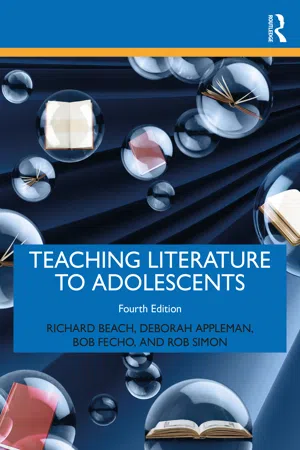
- 312 pages
- English
- ePUB (mobile friendly)
- Available on iOS & Android
Teaching Literature to Adolescents
About this book
Now in its fourth edition, this popular textbook introduces prospective and practicing English teachers to current methods of teaching literature in middle and high school classrooms. This new edition broadens its focus to cover important topics such as critical race theory; perspectives on teaching fiction, nonfiction, and drama; the integration of digital literacy; and teacher research for ongoing learning and professional development. It underscores the value of providing students with a range of different critical approaches and tools for interpreting texts. It also addresses the need to organize literature instruction around topics and issues of interest to today's adolescents. By using authentic dilemmas and contemporary issues, the authors encourage preservice English teachers and their instructors to raise and explore inquiry-based questions that center on the teaching of a variety of literary texts, both classic and contemporary, traditional and digital.
New to the Fourth Edition:
- Expanded attention to digital tools, multimodal learning, and teaching online
- New examples of teaching contemporary texts
- Expanded discussion and illustration of formative assessment
- Revised response activities for incorporating young adult literature into the literature curriculum
- Real-world examples of student work to illustrate how students respond to the suggested strategies
- Extended focus on infusing multicultural and diverse literature in the classroom
Each chapter is organized around specific questions that preservice teachers consistently raise as they prepare to become English language arts teachers. The authors model critical inquiry throughout the text by offering authentic case narratives that raise important considerations of both theory and practice. A companion website, a favorite of English education instructors, http://teachingliterature.pbworks.com, provides resources and enrichment activities, inviting teachers to consider important issues in the context of their current or future classrooms.
Frequently asked questions
- Essential is ideal for learners and professionals who enjoy exploring a wide range of subjects. Access the Essential Library with 800,000+ trusted titles and best-sellers across business, personal growth, and the humanities. Includes unlimited reading time and Standard Read Aloud voice.
- Complete: Perfect for advanced learners and researchers needing full, unrestricted access. Unlock 1.4M+ books across hundreds of subjects, including academic and specialized titles. The Complete Plan also includes advanced features like Premium Read Aloud and Research Assistant.
Please note we cannot support devices running on iOS 13 and Android 7 or earlier. Learn more about using the app.
Information
Part I
Why Should I Teach Literature?
Chapter 1
Why Teaching Literature Still Matters
Two Contrasting Theories of Teaching Literature
what Chilean writer Ariel Dorfman (1983, p. 7) calls a ‘social blueprint’ about what it means to be men, women, poor, people of color, gay, or straight. And that vision is political—whether it portrays the status quo or argues for a reorganization of society.(p. 54)
Table of contents
- Cover
- Half Title
- Title Page
- Copyright Page
- Table of Contents
- Preface
- Acknowledgements
- About the Authors
- Part I: Why Should I Teach Literature?
- Part II: What Texts Will Students Read and View in My Classroom?
- Part III: How Will I Teach Literature?
- Part IV: We Make the Road by Walking
- Index